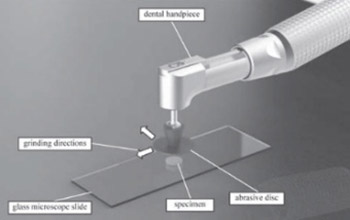Determination of surface roughness and topography of dental resin-based nanocomposites using AFM analysis
DOI:
https://doi.org/10.17305/bjbms.2013.2417Keywords:
dental polishing and finishing, resin-based composite, nanocomposite, nanoparticles, atomic force microscopy, surface roughness, topographyAbstract
The aim of this study was to determine surface roughness and topography of polished dental resin-based nanocomposites.
Four representative dental resin-based nanocomposites were tested in the study: two nanohybrids (Filtek Z550 and Tetric EvoCeram) and two nanofilled (Filtek Ultimate Body and Filtek Ultimate Translucent); and two reference materials: one microfilled (Gradia Direct) and one microhybrid (Filtek Z250). Polymerized cylindrical specimens (4 mm x 2 mm) were polished with multi-step polishing system-Super Snap. Immediately after the polishing, topography of each specimen was examined by Veeco di CP-II Atomic Force Microscope. Specimen’s surface has been scanned in 6 points in contact mode with CONT20A-CP tips. 1 Hz scan rate and 256 x 256 resolution were used to obtain topography on a 90 μm x 90 μm scanning area. Measured topography data were processed by Image Processing and Data Analysis V2.1.15 software. Following parameters were compared among specimens: average roughness and maximum peak-to-valley distance.
All of the tested materials had similar average surface roughness after finishing and polishing procedure. The lowest values occurred in the material Filtek Ultimate Body, and the highest in the Filtek Z550. When interpreting maximum peak-to-valley distance the larger differences in values (up to 100%) occurred in Filtek Z550, Filtek Z250 and Filtek Ultimate Body, which is a result of the deep polishing channels and tracks. Type, size, distribution of fillers and filler loading in tested materials, didn’t influence average roughness values, but had an impact on maximum peak-to-valley distance values.
Citations
Downloads

Downloads
Published
How to Cite
Accepted 2017-09-06
Published 2013-02-20









